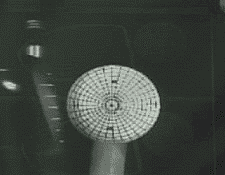Golf Impact Physics
Principle of Linear Impulse and Momentum,
Conservation of Linear Momentum,
Conservation of Kinetic Energy,
Coefficient of Restitution,
External Force.
Starting point : Newton's second law of motion.

![[Graphics:HTMLFiles/Impulse_collision_1_2.gif]](HTMLFiles/Impulse_collision_1_2.gif)
'Principle of linear impulse and momentum' applied to one object, (Fig1):

![[Graphics:HTMLFiles/Impulse_collision_1_4.gif]](HTMLFiles/Impulse_collision_1_4.gif)
Two objects colliding with direct central impact, (Fig2).
Objects come into contact at time t1 and separate at time t2.
During collision objects exert an impulsive inertial force on each other.
Applying 'principle of linear impulse and momentum' separately to each body:


![]()
Combining (4), (5) and (6) gives 'conservation of momentum' for two objects:

![[Graphics:HTMLFiles/Impulse_collision_1_9.gif]](HTMLFiles/Impulse_collision_1_9.gif)
To derive the 'coefficient of restitution' we consider the compression and restitution phase of the collision separately, (Fig3).
Compression phase:

Restitution phase:

Coefficient of restitution is defined as,

Combining (8), (9), (10), (11), (12) and (6) gives for the 'coefficient of restitution':

![]()




![[Graphics:HTMLFiles/Impulse_collision_1_19.gif]](HTMLFiles/Impulse_collision_1_19.gif)
Two colliding objects, with an external force, Fext, acting on one object, (Fig4).
Applying 'Principle of Linear Impulse and Momentum' separately on each body:

Combining (19), (20 and (21) and gives:

Coefficient of restitution is now given, not exactly, but with very great precision, by relation (14).

Combining (22) and (23) gives,

For impact of clubhead with golf ball, u(t1) = 0, hence,

Let's assume v(t1) = 44.7 m/s (100 mph), e = 0.7, m1 = 200 g, m2 = 46 g, impact duration Δt = t2 - t1 = 0.0004 sec.
From (15) → v(t2) = 30.4 m/s (68 mph).
Impact Force
The clubhead decelerates from 44.7 m/s (100 mph) to 30.4 m/s (68 mph) in 0.0004 sec, hence,

![[Graphics:HTMLFiles/Impulse_collision_1_26.gif]](HTMLFiles/Impulse_collision_1_26.gif)
If we assume the impact curve to be similar to Fig5 than the peak force is,
![]()
Hence there are really big forces at work during impact.
Shaft resistance to impact deceleration
The force F21 exerted by the golf ball on the clubhead causes a displacement of clubhead.
![]()
This displacement causes flexing of the shaft.

Reasonable value for equivalent deflection stiffness for driver, k= 140 N/m.
Maximum force exerted by the shaft on the clubhead resisting deceleration during impact is hence:
![]()
The resistance exerted by the shaft during impact is hence negligible small. Interesting experimental evidence is given by the high speed impact sequence Fig7 of driver and ball, no discernable deflection/rotation of the clubhead during impact.
(The analysis above is based on the traditional 'quasi-static' view of the shaft resisting impact. A true dynamic analysis however should consider the finite propagation time of the impact disturbance up and down the shaft.) 
Increase in ball departure velocity due to a torque on shaft exerted by golfer.
An reasonable value for the force exerted by shaft on clubhead due to torque applied by golfer, 20 N (4.5 lbs).
Using relation (27) gives for the increase in ball velocity due to force applied on clubhead,
![]()
Hence a negligible increase in ball departure velocity of only 0.05 %
![]()
There are those wo prefer to think in terms of kinetic energy even if ' conservation of momentum' is the ideal tool to analyse impacts. Let's therefore derive the relation between 'conservation of kinetic energy' and 'conservation of momentum'.
![]()
where Q represents the kinetic energy loss during the collision.
Using relations (17), (18), and (28) one can derive for the energy loss Q,
![]()
![]()
![[(m1 + e m2)/(m1 + m2)] * (m1 v^2 (t1))/2 + (m2 u^2 (t1))/2 ... bsp; + (m2 u^2 (t2))/2 ... ... ... ... ... ... ... ... . (30) ](HTMLFiles/Impulse_collision_1_35.gif)
![]()